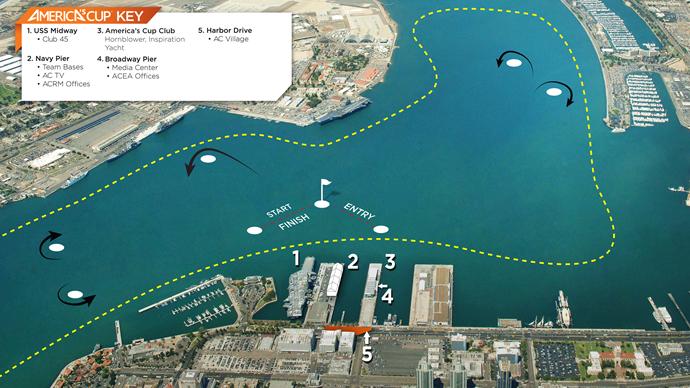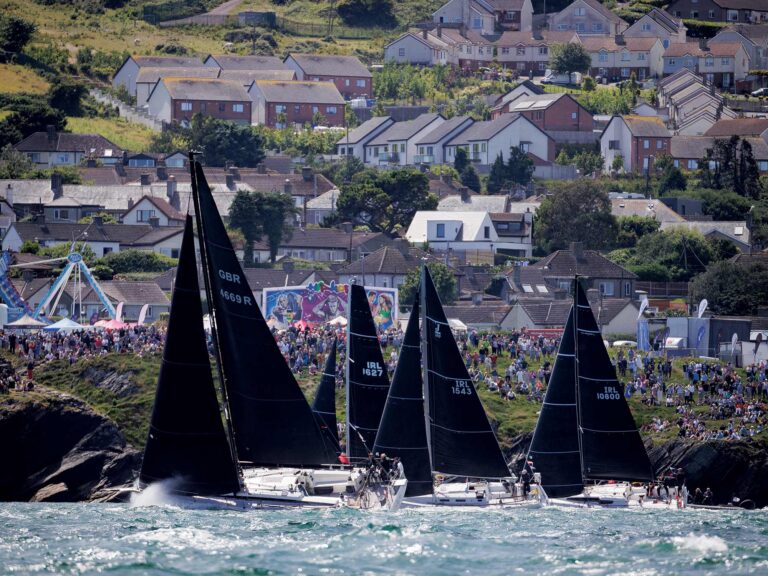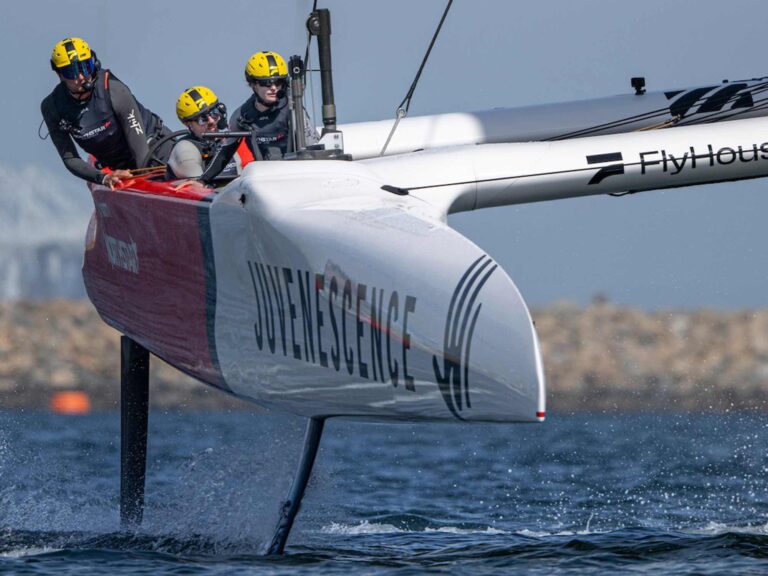
FBSanDiego
The third and final edition of the America’s Cup World Series 2011 takes place in San Diego, Nov. 12 to 20. With the AC45s already offloaded from the cargo ship and the event’s “little city” under construction, it’s all go in this West Coast sailing town.
On the water, conditions promise to be light, which could cause some changes on the leaderboard. “There’ll be a lot more finesse used here,” says regatta director Iain Murray. “Don’t be surprised to see the Europeans do very well.”
Currently, Emirates Team New Zealand sits in first place, with 38 points overall, just four points ahead of the U.S.-flagged Oracle Racing Spithill, with 34 points. Tied for third with 28 points are Oracle Racing Coutts (USA) and Artemis Racing (SWE), both of which plan to rotate in different crew for the regatta. Team Korea has been the sweet surprise over the past two events and sits in fifth place with 26 points. Aleph (FRA) and Energy Team (FRA) are tied in 6th place with 18 points. Both French teams will be racing with new crew in San Diego. Yann Guichard, who has just one day of competition with the team, will be subbing in for Energy Team skipper Loick Peyron; Pierre Pennec, Christophe Espagnon, and Thierry Fouchier—of Group Edmond de Rothschild, which currently holds second overall in the Extreme Sailing Series—will join Aleph in San Diego. Bringing up the rear are the Spanish entry Green Comm Racing—which had a spectacular collision with Artemis Racing in Plymouth—and China Team.
As the first stateside America’s Cup event under the new regime, the San Diego regatta could give U.S. fans a taste of what’s to come in San Francisco in 2013. “There’s a lot of interest here in America because the final event will be in San Francisco,” says Craig Thompson, CEO of America’s Cup Event Authority, whose hoping the San Diego event will help land some corporate sponsorships. “Companies are sending representatives to actually see our product, where they haven’t come to Portugal or England because of the travel distance.”
Thompson said corporate hospitality sales have been slow for San Diego, but he expects it’s more a function of the locale than anything. “We think that’s due more to the last-minute mentality of the region and expect an upsurge anytime. We really feel that we’ve established our product in the way that we’ve wanted to and are hopeful of a big turnout.”
Whereas three previous America’s Cup events held in San Diego took place miles offshore, the World Series racing will take place in the confines of the harbor. For those familiar with the venue, the racing area is similar to that used for the RC 44 event earlier this year, with most activity wedged between downtown, Harbor Island, and the back of Coronado Island.
Murray anticipates 8 to 14 knots of wind from the west and southwest, but I’m guessing we’ll see less than that. Competitors can expect a tight course—but no tighter to the courses set in Plymouth, says Murray—that’ll run up from a start near the aircraft carrier U.S.S. Midway, up around Harbor Island, then back down past the Midway to northwest of the Embarcadero Marina Park North, which will be the bottom mark in normal conditions, finishing back up by the Midway.
The base of race operations is located next to the Midway, which is now a naval aviation museum, on Navy Pier. Event hospitality will set up on the deck of the old aircraft carrier, which should provide quite the viewing platform if you’re lucky enough to catch an invite. Public spectating will be great from the AC Village at Harbor Drive and Broadway Pier, with views to the start and finish lines just off Navy and Broadway Piers.
Overall, the San Diego event will resemble recent stages in Cascais, Portugal, and Plymouth, England. The format will be slightly different, with just three seeding races held on Nov. 16, as opposed to the six raced in Plymouth. The match racing will unfold over three days instead of two, beginning Nov. 17.
“We found in Plymouth that the days were pretty long in quite strong breeze and long hours,” Murray says. “We don’t have the luxury of that time in San Diego, with the days getting shorter. Our hours of operation will be between 1 and 4 p.m., so instead of getting eight or nine races in a day, we’re aiming for six or seven. As always, we’ll be trying to start on time and finish on time.”
Murray’s also trying to add in a few more speed trials, even if speeds wont be as high as in Plymouth. Still, fans are loving this new form of short course racing. “You could use analogies to drag racing or the short ovals in NASCAR,” says Murray. “It’s a very simplified form of sailing that actually demands the pure ingredient of what we do, which is finding the speed over a short period of time.”
America’s Cup Race Management’s team of boatbuilders is in San Diego installing replacement parts that were made in New Zealand and shipped to San Diego, so teams can start training as soon as possible.
One team that’s working around the clock is Artemis Racing. The team’s AC45 sustained a ton of damage in the Plymouth collision with GreenComm. Artemis skipper Terry Hutchinson says that his team hasn’t done much training since, as they’ve been too busy fixing the boat. Their spare hull arrived mid-October, so they have a lot of work to do in a short time, including fixing their wing sail that was damaged when a crew member fell through it during the Plymouth capsize. “The guys have been flat-out getting the spare hull repaired,” he says. “We had some damage to our port hull as well to take care of.”
The San Diego event will incorporate a few changes on the race management side of things, especially when it comes to dealing with crashes and damaged boats. Murray says they’ve learned a lot about how to manage those situations, from righting the boats to keeping everything safe.
New lights installed on the boats should make the umpiring clearer and more understandable, telling competitors and spectators when a team is in or out of a zone, when they’re approaching boundaries, and when they’re in penalty situations. “We’re clarifying those rules, and this time around you’ll see bow lights when they’re in and out of the zone, which is for the competitors,” Murray explained. “You’ll also see a big flashing dome on the back of the boat, which will indicate a protest.”
This information flow helps the sailors on the water and lets commentators in the broadcast booth make the racing less complicated for television audiences. But Hutchinson thinks the electronic umpiring is still somewhat of a struggle at times. His team fell victim in Plymouth to a situation where they called a green flag but were denied the foul on the water, an incident that affected the outcome of the race. The next day, during the morning review session, the umpires overturned their decision in Artemis’ favor. “It didn’t really matter how the situation evolved or developed, because the umpires were always going to see it a little bit differently than how you saw it on the boat,” Hutchinson says. “That’s what you’re always trying to understand—how they’re going to see it, not necessarily how you saw it. The difficult part is now it happens so much quicker, it’s hard really for both sides to keep up.”
But its all part of the learning process, and Hutchinson has his team focusing on big-picture stuff for San Diego with an eye toward scaling up to the AC72. “We’re rotating as many people as possible through the program, which is great,” he says. “If there’s one thing that the 45 is good for, it’s that. It does expose our sailing team to high-paced, high-action sailing. The courses and the type of racing that we’re doing is a micro of what we’ll be doing on the 72. You definitely get an appreciation for how quick and fast everything happens.”
Meanwhile, the defender Oracle Racing (USA) has been training and testing two of their four AC45s in San Francisco over the past three weeks. The team plans to be in San Diego by November 6 to do some additional training. “We’ve been working on stuff related to the 72, so getting to San Diego earlier will give us a bit more time to prepare,” says Oracle trimmer Joey Newton. “The last few regattas, we felt we left it a bit short and didn’t have enough time to get organized and practice enough beforehand.”
Oracle also has a couple of new guys on board, including Australians Darren Bundock, who will be replacing Russell Coutts as skipper, and 2010 World Sailor of the Year Tom Slingsby calling tacics. “We have a lot of practice to do against them and are looking forward to having someone new to race against,” says Newton.
The World Series allows teams to measure in just two jibs pre regatta, and for the previous events most teams measured in their smaller jibs. Newton thinks that, with the lighter breeze in San Diego, most teams will measure in their biggest jibs. “We’ve done a bit of work on our gennakers,” he says. “We’ve had all the sails sitting there to be used for the lighter air stuff but haven’t had much opportunity to use them. We’ll do a bit of testing when we get there and try to put our best foot forward, but it’s pretty difficult when you’re only allowed to use two jibs and get the right one up all the time.”
With only have one jib on board and the other on the chase boat, and races turning around in about six minutes, that’s right on the limit for a quick change, says Newton. “You can change a jib, but you don’t want everything to go wrong to end up with no jib up.”
Newton and Hutchinson agree that the AC45s are a physical challenge, especially for the three guys in front. “It’s a lot harder than anything I’ve done before,” says Newton, a former match racer.
Light or not, San Diego will prove to be just as hard as Cascais and Plymouth. “In many ways, sailing in 12 knots is about as hard physically as you can do,” says Newton. “It’s easier sailing in 20-25 knots, because you’re using smaller sails. The maximum jib loads on these boats is probably at about 8 knots, and then it starts going down from there as you start using smaller sails. Racing in 12 will be every bit as hard or harder than sailing in 25. And the helmsmen tend to turn them around a lot more in light air than they do when it’s windy. It’ll be plenty hard.”
Take Iain Percy, the longtime British Olympic sailor, who joined Artemis Racing in Plymouth for his first shot on the 45. According to Murray, Percy got off his first ride on the 45 and said, “That’s the hardest race I’ve ever done in my life.” After 20 or 30 minutes of racing, Percy checked in with an average heart rate of 185, which, according to his trainer, is 97-pecent of his maximum heart rate tested over the last 10 years. “It’s is a staggering statistic to the physicality of sailing these boats, and I think that’s fantastic,” says Murray.
After spending the last year figuring out how to pull it off, Murray wears a big smile heading into the San Diego event. “To get it on in Cascais and make it work was a huge relief,” he says. “We perfected it more in Plymouth with boundaries on the course that push the boats back into the middle, which adds to the sailing of these boats and provides the opportunities for crews to get on top of managing these boats around the racecourse. It’s a whole new thing that we’ve made happen.”









